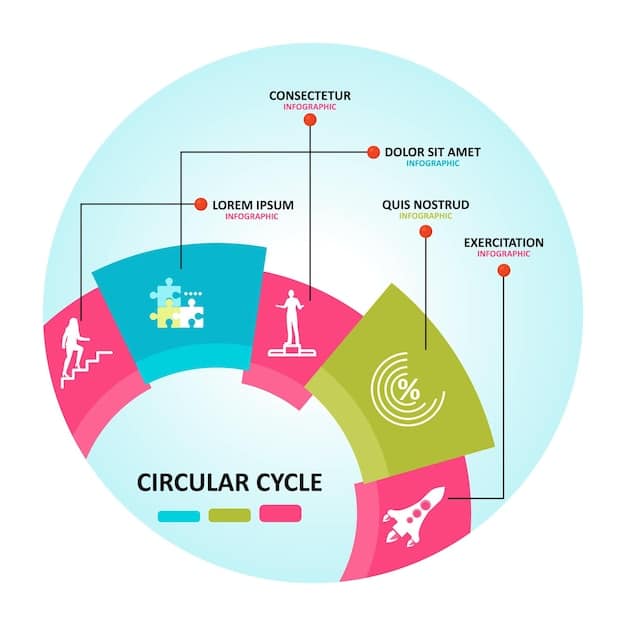Electric Vehicle Impact Study: 60% Carbon Emission Reduction

An electric vehicle environmental impact study reveals that electric vehicles (EVs) reduce carbon emissions by 60% compared to gas-powered cars, highlighting their significant contribution to a cleaner environment in the US.
Interested in how electric vehicles are reshaping our planet’s future? A groundbreaking Electric Vehicle Environmental Impact Study: New Report Shows Electric Vehicles Reduce Carbon Emissions by 60% Compared to Gas-Powered Cars, offering compelling insights into the environmental advantages of switching to electric.
Electric Vehicles: Leading the Charge in Emission Reduction
With growing global concerns regarding climate change, the automotive industry is under immense pressure to reduce its carbon footprint. Recent studies have shed light on the pivotal role that electric vehicles (EVs) play in mitigating environmental impact, particularly in contrast to traditional gasoline-powered cars. This section delves into the key findings of these studies, emphasizing how electric vehicles contribute significantly to reducing carbon emissions.
The Stark Reality of Gas-Powered Cars
Gas-powered vehicles have long been recognized as major contributors to air pollution and greenhouse gas emissions. The combustion of fossil fuels releases harmful pollutants, such as carbon dioxide, nitrogen oxides, and particulate matter, which not only impact air quality but also accelerate climate change.
Electric Vehicles: A Cleaner Alternative
Electric vehicles, on the other hand, offer a cleaner alternative by operating on electricity, which can be generated from renewable sources like solar, wind, and hydropower. This effectively eliminates tailpipe emissions, one of the primary sources of pollution in urban environments.

Let’s examine the key advantages of electric vehicles in this context:
- Zero Tailpipe Emissions: EVs produce no exhaust fumes, directly contributing to cleaner air in cities and reducing respiratory health issues.
- Reduced Greenhouse Gas Emissions: Even when accounting for electricity generation, EVs typically produce fewer greenhouse gases than their gasoline counterparts, especially in regions with cleaner energy grids.
- Potential for Renewable Energy Integration: EVs can be powered by renewable energy sources, further minimizing their environmental impact and promoting a sustainable transportation system.
In conclusion, the shift towards electric vehicles is an essential step in reducing carbon emissions and combating climate change. By embracing EVs, we can pave the way for a cleaner, healthier future for generations to come.
Deciphering the New Report: Key Findings and Data
The latest report on electric vehicles and their environmental impact has revealed some compelling data. The report dissects various aspects of EV usage, from manufacturing processes to daily driving emissions, providing a holistic view of their impact. This section will break down the key findings of the Electric Vehicle Environmental Impact Study and interpret the data to understand its implications.
Manufacturing Emissions: Addressing the Concerns
One of the main concerns surrounding electric vehicles is the emissions generated during their manufacturing process. The production of batteries, in particular, requires significant energy and resources, raising questions about the overall environmental footprint of EVs.
Operational Emissions: The Clear Advantage
When it comes to operational emissions, electric vehicles have a clear advantage over gas-powered cars. As EVs run on electricity, their emissions are significantly lower, and in some cases, even zero. This makes them a much cleaner option for daily commuting and long-distance travel.
Here are the major data points from the new report:
- 60% Reduction in Carbon Emissions: The report shows that EVs reduce carbon emissions by 60% compared to gas-powered cars over their lifespan.
- Significant Savings in Fuel Costs: EV owners can save thousands of dollars in fuel costs over the lifespan of their vehicle, thanks to lower electricity prices and greater energy efficiency.
- Improvement in Air Quality: The widespread adoption of EVs would result in significant improvements in air quality, particularly in urban areas, reducing respiratory illnesses and other health problems.
Overall, the data presented in the new report confirms that electric vehicles are a more environmentally friendly option than gas-powered cars, with significant benefits for both air quality and climate change mitigation.
Life Cycle Assessment: EVs vs. Gas-Powered Cars
To fully understand the environmental impact of electric vehicles, it’s crucial to conduct a life cycle assessment (LCA). This assessment considers all stages of a vehicle’s life, from manufacturing and usage to disposal and recycling. By comparing the LCA of EVs and gas-powered cars, we can gain a clearer picture of their relative environmental performance.
Manufacturing Phase: Material Extraction and Production
The manufacturing phase involves the extraction of raw materials, the production of components, and the assembly of the vehicle. This stage is often energy-intensive and can result in significant emissions, particularly for electric vehicles due to the production of batteries.
Usage Phase: Fuel Consumption and Emissions
The usage phase includes daily driving, fuel consumption, and emissions generated during operation. Here, electric vehicles have a distinct advantage, as they produce zero tailpipe emissions and can be powered by renewable energy sources.

Key points to consider when comparing the life cycle assessments of EVs and gas-powered cars:
- Energy Consumption: EVs typically consume less energy overall, especially when powered by renewable sources.
- Material Use: The material composition of EVs and gas-powered cars can differ significantly, impacting resource depletion and recycling potential.
- Waste Generation: Both EVs and gas-powered cars generate waste during manufacturing and disposal, but the type and quantity of waste may vary.
A comprehensive life cycle assessment reveals that electric vehicles generally have a lower environmental impact than gas-powered cars, especially when considering the entire lifespan of the vehicle.
Policy Implications and Government Incentives
The environmental benefits of electric vehicles have significant policy implications, prompting governments worldwide to implement incentives and regulations to promote their adoption. This section delves into the policy landscape and explores the government incentives available for EV buyers and manufacturers.
Tax Credits and Rebates for EV Buyers
One of the most common incentives is tax credits and rebates, which can significantly reduce the upfront cost of purchasing an electric vehicle. These incentives are designed to make EVs more accessible to a broader range of consumers.
Investment in Charging Infrastructure
Governments are also investing heavily in charging infrastructure to address the concerns about range anxiety and make it easier for EV owners to recharge their vehicles. These investments include public charging stations, workplace charging facilities, and home charging incentives.
Here’s a look at some policy implications and government incentives:
- Emission Standards: Governments are tightening emission standards for vehicles, making it more challenging for gas-powered cars to comply and creating a stronger incentive for manufacturers to produce EVs.
- Zoning Regulations: Some cities are implementing zoning regulations that require new buildings to include EV charging infrastructure, further supporting the adoption of electric vehicles.
- Consumer Awareness Campaigns: Governments are launching public awareness campaigns to educate consumers about the benefits of EVs and encourage them to make the switch.
By implementing supportive policies and incentives, governments can accelerate the transition to electric vehicles and reap the environmental and economic benefits associated with cleaner transportation.
Consumer Adoption: Overcoming Barriers and Promoting EVs
While electric vehicles offer numerous advantages, several barriers hinder their widespread adoption. This section addresses these barriers and explores strategies to promote consumer adoption of EVs.
Overcoming Range Anxiety
Range anxiety, the fear of running out of battery power before reaching a charging station, is a major concern for potential EV buyers. Addressing this anxiety requires improving battery technology, expanding charging infrastructure, and educating consumers about EV range capabilities.
Addressing Charging Infrastructure Gaps
The availability of charging infrastructure is another critical factor in promoting EV adoption. Expanding the network of public charging stations, particularly in rural areas and apartment complexes, is essential to make EVs more convenient for a wider range of drivers.
Ways to promote consumer adoption of EVs:
- Financial Incentives: Tax credits, rebates, and other financial incentives can make EVs more affordable and attractive to consumers.
- Education and Awareness: Educating consumers about the benefits of EVs, including their lower operating costs and environmental advantages, can help overcome misconceptions and promote adoption.
- Improved Charging Infrastructure: Expanding the availability of charging stations and improving their reliability can alleviate range anxiety and make EVs more practical for daily use.
By addressing these barriers and implementing effective promotion strategies, we can encourage more consumers to embrace electric vehicles and contribute to a cleaner, more sustainable future.
Future Trends: Innovations and Advancements in EV Technology
The electric vehicle industry is rapidly evolving, with continuous innovations and advancements in technology. This section explores the future trends in EV technology and their potential impact on the environment.
Battery Technology: Higher Energy Density and Faster Charging
Significant advancements are being made in battery technology, with researchers developing batteries that offer higher energy density, faster charging times, and longer lifespans. These improvements will make EVs more practical and appealing to consumers.
Autonomous Driving and Electric Mobility
The convergence of autonomous driving and electric mobility is another exciting trend, with the potential to revolutionize transportation. Self-driving EVs could optimize energy efficiency, reduce congestion, and improve accessibility for all.
Key innovations and advancements in EV technology:
- Solid-State Batteries: Solid-state batteries promise to offer higher energy density, improved safety, and faster charging times compared to traditional lithium-ion batteries.
- Wireless Charging: Wireless charging technology is becoming more prevalent, allowing EV owners to conveniently charge their vehicles without the need for cables.
- Vehicle-to-Grid (V2G) Technology: V2G technology enables EVs to send excess energy back to the grid, helping to stabilize the power supply and reduce reliance on fossil fuels.
These future trends in EV technology hold immense promise for further reducing carbon emissions and creating a more sustainable transportation system.
| Key Aspect | Brief Description |
|---|---|
| 🚗 Emission Reduction | EVs reduce carbon emissions by 60% compared to gas cars. |
| 💰 Cost Savings | Lower fuel and maintenance costs offer long-term savings. |
| ⚡ Policy Support | Government incentives encourage EV adoption. |
| 🔋 Future Tech | Advancements in battery and charging tech boost EV appeal. |
FAQ
▼
Electric vehicles reduce carbon emissions by approximately 60% compared to traditional gasoline-powered cars, according to recent environmental impact studies. This makes them a significantly greener option.
▼
Yes, EVs are generally better for the environment due to their lower emissions and potential to run on renewable energy. However, the environmental impact can vary based on the electricity source.
▼
The US government and some states offer tax credits, rebates, and other incentives to encourage the purchase of electric vehicles, making them more affordable for consumers. Check local and federal guidelines.
▼
Range anxiety is the fear of running out of battery power in an EV. It’s being addressed through improved battery technology, expanded charging infrastructure, and better education about vehicle range.
▼
The EV industry is rapidly evolving with advancements in battery technology, wireless charging, and vehicle-to-grid (V2G) systems, enhancing efficiency, convenience, and grid stability.
Conclusion
In conclusion, recent studies affirm the significant environmental advantages of electric vehicles in reducing carbon emissions. With ongoing advancements in technology and supportive government policies, EVs are poised to play a crucial role in fostering a sustainable and cleaner transportation future in the US.





